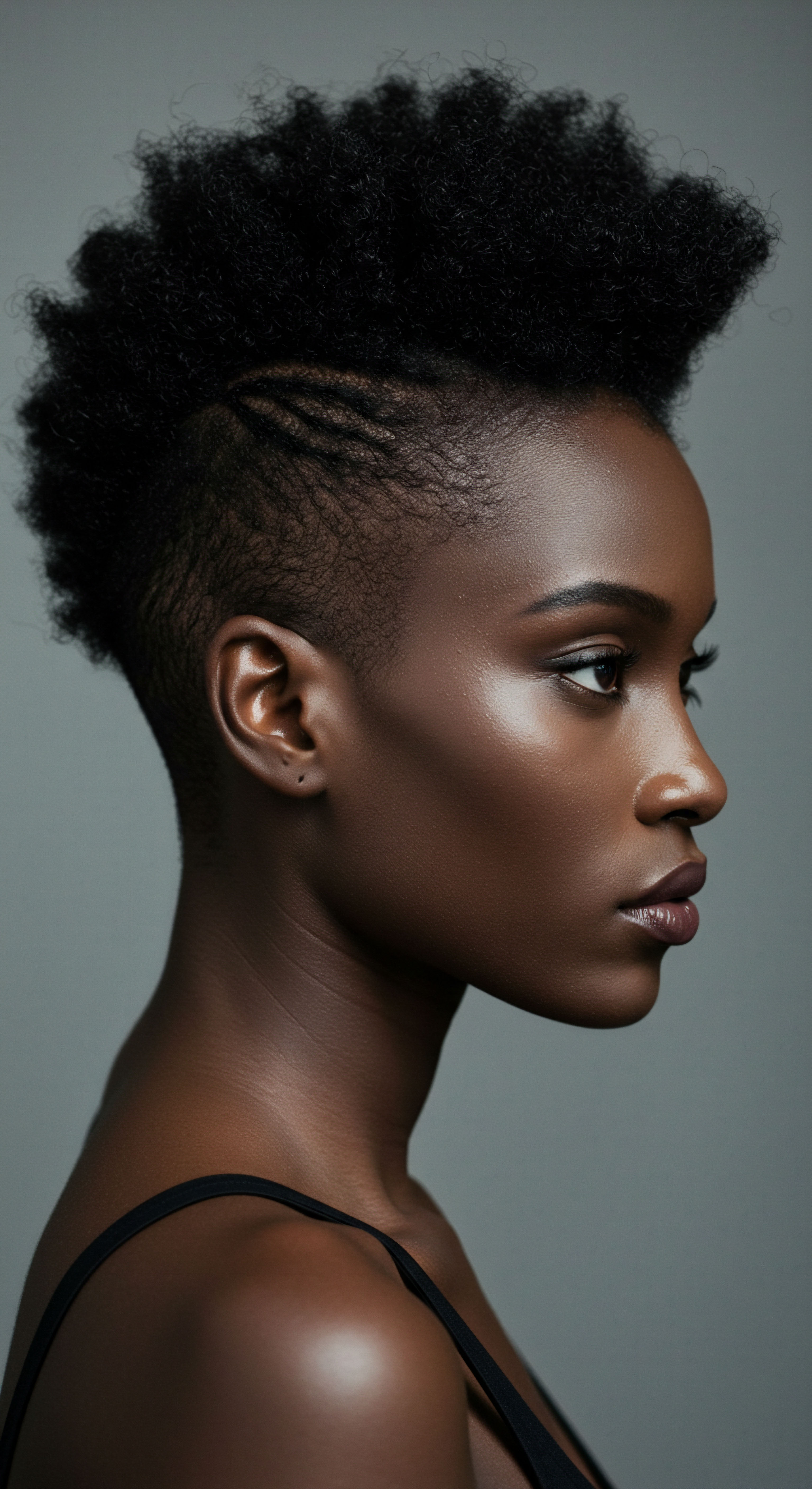
Roots
The whisper of a gentle breeze through a canopy of curls, the way light dances on a perfectly defined coil—these moments remind us of the living wonder that is hair. For many, particularly those with textured strands, hair is more than just an adornment; it is a profound connection to heritage, a canvas of identity, and a testament to resilience. In this intimate dialogue with our bodies, we often overlook a silent, yet powerful, partner in our hair’s vitality ❉ the quiet hours of slumber. The question of whether consistent sleep patterns truly affect hair thickness invites us into a deeper conversation, one that begins at the very cellular foundations of our being.
Hair, in its fundamental nature, is a complex biological marvel, each strand a delicate extension of our scalp’s intricate ecosystem. To truly appreciate the subtle influence of sleep, we must first journey inward, past the visible shaft, to the unseen processes beneath the surface. Our hair does not simply grow; it cycles through distinct phases, a rhythmic performance orchestrated by the body’s internal timing. This dance of growth, transition, and rest dictates the very abundance and strength of our tresses.

Hair Anatomy and Physiology
At the heart of each hair lies the Follicle, a tiny organ nestled within the skin, acting as the dynamic factory for hair production. These follicles are not static structures; they are alive with activity, a hub of cellular division and protein synthesis. The hair shaft itself, primarily composed of keratin, emerges from this follicle, its thickness determined by the diameter of the follicle and the vigor of its cellular machinery. Textured hair, with its unique helical structure, presents varying degrees of curl and coil, influencing how light reflects and how strands behave, yet the underlying biological processes remain universal to all hair types.
Within the follicle, a specialized group of cells known as the Dermal Papilla plays a critical role, sending signals that regulate hair growth. Surrounding these are the hair matrix cells, which rapidly divide and differentiate to form the hair shaft. This bustling activity requires a steady supply of nutrients, oxygen, and precise hormonal cues, all of which are finely tuned by the body’s overall physiological state.
Hair thickness finds its origin in the delicate dance of cellular activity within each follicle, a process deeply connected to our body’s fundamental rhythms.

Hair Growth Cycles and Influencing Factors
The journey of each hair strand unfolds across three primary phases:
- Anagen ❉ This is the active growth phase, where hair cells rapidly divide, pushing the hair shaft outward. For scalp hair, this period can span several years, determining the ultimate length a strand can attain. The longer a hair remains in anagen, the more potential it has for substantial growth.
- Catagen ❉ A brief transitional phase, lasting only a few weeks, where hair growth ceases, and the follicle shrinks. It marks the end of active production.
- Telogen ❉ The resting phase, typically lasting a few months, during which the hair is inactive before it sheds. A new hair often begins to grow in the same follicle as the old one prepares to release.
The precise timing and healthy progression through these cycles are fundamental to maintaining hair density and thickness. When this delicate balance is disturbed, whether by internal or external stressors, the ratio of hairs in the anagen phase can decrease, while those in the telogen phase might increase, leading to noticeable thinning or excessive shedding. Our daily habits, from the nourishment we seek to the tranquility we find, undeniably contribute to the orchestration of this follicular symphony.
Factors such as genetic predisposition, hormonal shifts, nutritional adequacy, and levels of physiological stress are well-known influences on these cycles. However, the often-overlooked yet profound impact of consistent, restorative sleep begins to surface as we consider the body’s holistic well-being. It is during these hours of repose that many vital reparative and regenerative processes, essential for the continuous renewal of our hair, truly take hold.

Ritual
As we turn from the foundational understanding of hair’s inner workings, our gaze shifts toward the tangible practices that shape our hair’s daily existence. The rhythms of our lives, the gentle acts of care, and the mindful moments we dedicate to our strands are all part of a quiet ritual. Can these deliberate practices, particularly those surrounding our nightly repose, truly contribute to the abundance and vitality of our hair? The answer unfolds as we consider the subtle yet powerful ways our nocturnal habits intersect with our hair’s well-being.
The concept of “beauty sleep” is far from a mere cultural adage; it carries a deep resonance rooted in biological truth. The body, a master of self-preservation and renewal, dedicates the hours of darkness to intricate repair mechanisms, hormonal regulation, and cellular regeneration. For textured hair, which often requires an extra measure of tenderness and protection, these nighttime rituals become even more significant, safeguarding against friction, moisture loss, and mechanical stress.

The Nighttime Sanctuary ❉ Essential Sleep Protection
Protecting textured hair during sleep is a time-honored practice, passed down through generations, and now supported by an understanding of its practical benefits. The friction between hair and rough pillowcases can lead to cuticle damage, breakage, and the loss of precious moisture, ultimately diminishing the appearance of thickness and overall health.
Consider the simple yet profound act of preparing hair for rest:
- Loose Protective Styles ❉ Gently braiding, twisting, or pineapple-ing hair before bed minimizes tangling and reduces surface area exposure to friction. This preserves curl patterns and prevents unnecessary stress on individual strands.
- Silk or Satin Bonnets and Scarves ❉ These soft, smooth coverings create a barrier against abrasive fabrics, allowing hair to glide freely. They help maintain the hair’s natural moisture balance, preventing the dry, brittle feeling that can lead to breakage.
- Silk or Satin Pillowcases ❉ For those who prefer not to cover their hair, or as an added layer of defense, a silk or satin pillowcase offers a frictionless surface, significantly reducing tugging and snagging during movement.
These practices are not simply about preventing immediate damage; they contribute to the long-term health of the hair shaft, helping to preserve its structural integrity and, by extension, its perceived thickness. Less breakage over time means more length retention and a fuller appearance.

Does Hair Thickness Change Overnight?
While a single night of restorative sleep will not instantly transform fine strands into robust coils, consistent patterns of adequate rest contribute to an environment where hair can thrive. The changes in hair thickness are not sudden, but rather a cumulative effect of sustained biological support. Over time, hair that is consistently nurtured through proper sleep and protective measures experiences less shedding due to breakage, maintains better moisture, and supports healthier growth cycles. This cumulative effect lends itself to a more substantial and resilient mane.
Consistent sleep patterns, paired with mindful nighttime hair protection, cultivate an environment where hair can flourish, leading to a sustained appearance of thickness and vitality.
A structured approach to nighttime care becomes a ritual of self-preservation, a testament to the understanding that external care and internal well-being are inextricably linked.
| Benefit Area Reduced Breakage |
| Mechanism of Action Minimizes friction with sleep surfaces |
| Impact on Thickness Preserves existing length and density, contributing to a fuller appearance. |
| Benefit Area Moisture Retention |
| Mechanism of Action Prevents moisture evaporation to fabrics |
| Impact on Thickness Maintains hair elasticity, reducing brittleness and subsequent thinning. |
| Benefit Area Curl Pattern Preservation |
| Mechanism of Action Protects delicate curl definition |
| Impact on Thickness Less manipulation needed in the morning, reducing stress and potential damage. |
| Benefit Area Scalp Health Support |
| Mechanism of Action Reduces physical stress on scalp |
| Impact on Thickness A healthy scalp is a foundation for robust hair growth. |
| Benefit Area These nightly practices contribute to the cumulative health and perceived thickness of textured hair. |
The seemingly small acts of preparing hair for sleep hold a quiet power, reinforcing the idea that beauty is a continuous act of care, a gentle conversation between our bodies and the world around us.

Relay
Our exploration now extends into the deeper currents that govern hair vitality, moving beyond observable practices to the unseen biological dialogues. The question of consistent sleep patterns and hair thickness invites us to consider the profound, interconnected systems that operate beneath the surface, where science, cultural wisdom, and intricate details converge. It is here, in the subtle orchestration of our internal world, that the full spectrum of sleep’s influence on hair density truly reveals itself.
The human body is a marvel of internal timing, governed by an intrinsic clock that regulates nearly every physiological process, from hormone secretion to cellular repair. This biological rhythm, known as the Circadian System, is profoundly affected by our sleep patterns. When these patterns are disrupted, the delicate balance of our internal environment can waver, casting a long shadow over seemingly distant functions, including the robust growth of our hair.

How Does Circadian Rhythm Influence Hair Follicle Activity?
The hair follicle, far from being a passive structure, possesses its own localized biological clock. Research indicates that certain Clock Genes, such as BMAL1 and PER1, are expressed within hair follicles and play a role in regulating the hair growth cycle itself. These genes help dictate the timing of cellular division and differentiation within the follicle, influencing when hair enters its active growth phase and when it transitions to rest.
When sleep patterns become inconsistent, this can disrupt the synchronization between the central circadian clock (located in the brain) and these peripheral clocks within the hair follicles. A notable study, for instance, revealed that disruptions to circadian rhythms, particularly those experienced by individuals in shift work, correlated with diminished stem cell activity in hair follicles. This suggests a direct physiological pathway through which irregular sleep can impede the very regenerative capacity of our hair, potentially leading to reduced thickness over time. The stem cells responsible for hair regeneration, if consistently deprived of their optimal timing cues, may not perform with their full potential, resulting in a less vigorous growth cycle.

What Hormonal Responses Affect Hair Thickness?
Beyond the intrinsic clocks, sleep acts as a master regulator of our hormonal landscape, a symphony of chemical messengers that directly impact hair health.
One of the most widely discussed connections involves Cortisol, often termed the “stress hormone.” Chronic sleep deprivation elevates cortisol levels in the body. Sustained high levels of cortisol can push a greater proportion of hair follicles into the resting (telogen) phase prematurely, leading to a condition known as Telogen Effluvium, characterized by increased shedding and a noticeable reduction in overall hair density. This effect is not instantaneous but accumulates over time, making consistent, quality sleep a vital buffer against this stress-induced thinning.
Conversely, sleep is the prime time for the release of beneficial hormones. Growth Hormone (GH) and Insulin-Like Growth Factor 1 (IGF-1), both critical for cellular repair and regeneration, peak during deep, non-REM sleep stages. These hormones provide the necessary fuel for the rapid cell division that characterizes the anagen (growth) phase of hair. A lack of sufficient deep sleep means a diminished release of these regenerative compounds, potentially hindering the hair’s ability to achieve its fullest, healthiest growth.
Moreover, Melatonin, the hormone known for regulating our sleep-wake cycle, also possesses receptors in hair follicles and has been observed to influence hair growth directly. Melatonin has been shown to prolong the anagen phase, extending the period of active hair growth, and also exhibits antioxidant properties that protect hair follicles from oxidative stress. When sleep patterns are erratic, melatonin production can be compromised, potentially shortening the anagen phase and allowing hair to enter the resting and shedding phases more quickly.
The silent hours of consistent sleep are not passive; they actively orchestrate hormonal balance and cellular regeneration, profoundly shaping the very thickness and vitality of our hair.

How Can We Measure the Connection?
The intricate relationship between sleep quality and hair health extends to measurable physiological markers. Hair itself can serve as a long-term record of stress and sleep patterns. For example, Hair Cortisol Concentration (HCC) has emerged as a promising biomarker for assessing chronic stress levels and, by extension, can offer insights into sleep quality. Studies have found that individuals with higher HCC levels are more prone to sleep disturbances, indicating a reciprocal relationship where stress impacts sleep, and poor sleep perpetuates stress, both of which can detrimentally affect hair.
This interplay suggests that hair thickness is not merely a cosmetic attribute but a visible indicator of systemic health and the profound impact of consistent, restorative sleep. The understanding that our hair follicles possess their own biological clocks, synchronized with our central circadian system, underscores the holistic approach necessary for truly robust and thriving hair. It is a reminder that the seemingly simple act of sleeping is a complex, vital process that reverberates through every cell of our being, including those responsible for the crowning glory of our textured strands.

Reflection
As our exploration draws to a close, the threads of science, cultural wisdom, and personal experience converge into a clear understanding ❉ the quiet hours of consistent sleep hold a profound power over the vitality and thickness of our hair. This journey has revealed that our hair is not merely a collection of inert fibers, but a dynamic, living part of us, deeply attuned to the rhythms of our inner world. The dedication to restorative rest is not a luxury; it is a foundational act of care, a gentle yet potent investment in the long-term resilience and abundance of our textured strands. May this deeper knowing inspire a renewed reverence for the sacred space of slumber, allowing our hair to truly flourish in its full, glorious expression.

References
- Chang, S. et al. (2019). “Circadian Disruption Impairs Hair Follicle Stem Cell Function.” Cell Reports, Vol. 28, No. 11, pp. 2910-2921.
- Choi, S. et al. (2021). “Corticosterone Inhibits GAS6 Production in Dermal Papilla Cells to Induce Hair Follicle Stem Cell Quiescence.” Nature, Vol. 591, No. 7851, pp. 600-606.
- Fischer, T. W. et al. (2004). “Melatonin Receptors in Human Hair Follicles ❉ A Potential Target for the Treatment of Androgenetic Alopecia.” Journal of Pineal Research, Vol. 36, No. 3, pp. 190-197.
- Geylikman, M. & Kroumpouzos, G. (2015). “Lifestyle Factors and Hair Loss ❉ A Review.” Journal of Clinical and Aesthetic Dermatology, Vol. 8, No. 11, pp. 38-42.
- Hardman, J. G. et al. (2001). Goodman & Gilman’s The Pharmacological Basis of Therapeutics. McGraw-Hill.
- Oh, S. S. et al. (2022). “Association Between Sleep Disturbance and Alopecia Areata.” Annals of Dermatology, Vol. 34, No. 1, pp. 43-48.
- Peters, E. M. et al. (2007). “Neurobiology of Hair Follicle Immune Privilege.” Journal of Investigative Dermatology, Vol. 127, No. 6, pp. 1321-1332.
- Paus, R. & Cotsarelis, G. (1999). “The Biology of Hair Follicles.” The New England Journal of Medicine, Vol. 341, No. 7, pp. 491-497.
- Plonka, P. M. et al. (2019). “The Role of Melatonin in Hair Follicle Biology.” International Journal of Molecular Sciences, Vol. 20, No. 17, pp. 4297.
- Sakamoto, R. et al. (2023). “Hair Cortisol Concentration and Sleep Quality Indicators in Perimenopausal and Menopausal Women.” Endocrine Connections, Vol. 12, No. 7, e230070.
- Yang, Y. et al. (2023). “Melatonin Regulates the Periodic Growth of Secondary Hair Follicles Through the Nuclear Receptor RORα.” Frontiers in Physiology, Vol. 14, pp. 1198642.